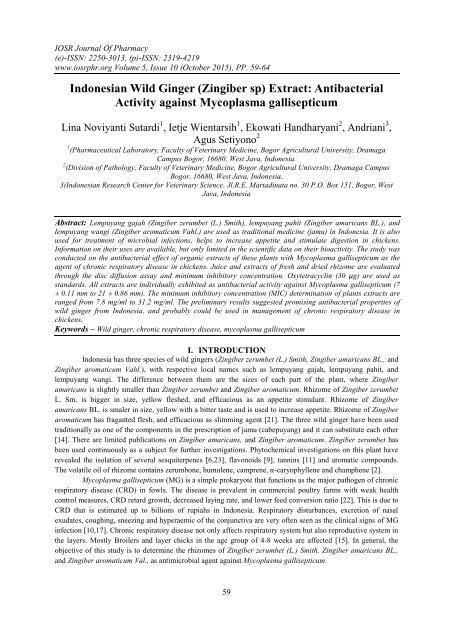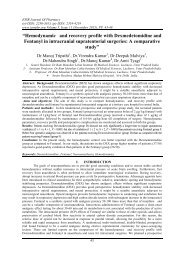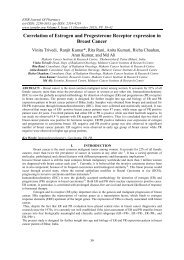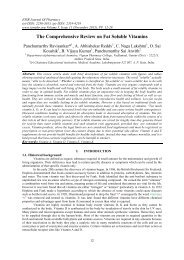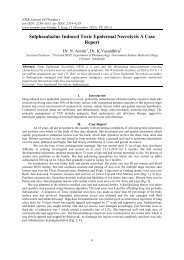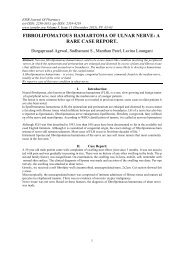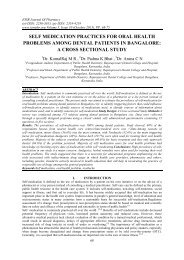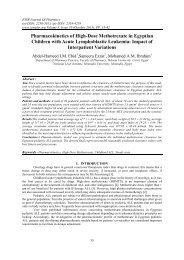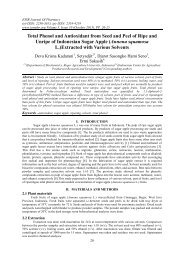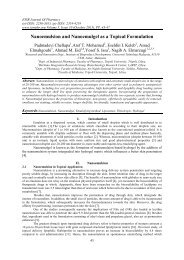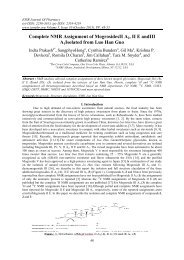Indonesian Wild Ginger (Zingiber sp) Extract: Antibacterial Activity against Mycoplasma gallisepticum
Lempuyang gajah (Zingiber zerumbet (L.) Smith), lempuyang pahit (Zingiber amaricans BL.), and lempuyang wangi (Zingiber aromaticum Vahl.) are used as traditional medicine (jamu) in Indonesia. It is also used for treatment of microbial infections, helps to increase appetite and stimulate digestion in chickens. Information on their uses are available, but only limited in the scientific data on their bioactivity. The study was conducted on the antibacterial effect of organic extracts of these plants with Mycoplasma gallisepticum as the agent of chronic respiratory disease in chickens. Juice and extracts of fresh and dried rhizome are evaluated through the disc diffusion assay and minimum inhibitory concentration. Oxytetracyclin (30 μg) are used as standards. All extracts are individually exhibited as antibacterial activity against Mycoplasma gallisepticum (7 ± 0.11 mm to 21 ± 0.86 mm). The minimum inhibitory concentration (MIC) determination of plants extracts are ranged from 7.8 mg/ml to 31.2 mg/ml. The preliminary results suggested promising antibacterial properties of wild ginger from Indonesia, and probably could be used in management of chronic respiratory disease in chickens.
Lempuyang gajah (Zingiber zerumbet (L.) Smith), lempuyang pahit (Zingiber amaricans BL.), and lempuyang wangi (Zingiber aromaticum Vahl.) are used as traditional medicine (jamu) in Indonesia. It is also used for treatment of microbial infections, helps to increase appetite and stimulate digestion in chickens. Information on their uses are available, but only limited in the scientific data on their bioactivity. The study was conducted on the antibacterial effect of organic extracts of these plants with Mycoplasma gallisepticum as the agent of chronic respiratory disease in chickens. Juice and extracts of fresh and dried rhizome are evaluated through the disc diffusion assay and minimum inhibitory concentration. Oxytetracyclin (30 μg) are used as standards. All extracts are individually exhibited as antibacterial activity against Mycoplasma gallisepticum (7 ± 0.11 mm to 21 ± 0.86 mm). The minimum inhibitory concentration (MIC) determination of plants extracts are ranged from 7.8 mg/ml to 31.2 mg/ml. The preliminary results suggested promising antibacterial properties of wild ginger from Indonesia, and probably could be used in management of chronic respiratory disease in chickens.
You also want an ePaper? Increase the reach of your titles
YUMPU automatically turns print PDFs into web optimized ePapers that Google loves.
IOSR Journal Of Pharmacy<br />
(e)-ISSN: 2250-3013, (p)-ISSN: 2319-4219<br />
www.iosrphr.org Volume 5, Issue 10 (October 2015), PP. 59-64<br />
<strong>Indonesian</strong> <strong>Wild</strong> <strong>Ginger</strong> (<strong>Zingiber</strong> <strong>sp</strong>) <strong>Extract</strong>: <strong>Antibacterial</strong><br />
<strong>Activity</strong> <strong>against</strong> <strong>Mycoplasma</strong> <strong>gallisepticum</strong><br />
Lina Noviyanti Sutardi 1 , Ietje Wientarsih 1 , Ekowati Handharyani 2 , Andriani 3 ,<br />
Agus Setiyono 2<br />
1 (Pharmaceutical Laboratory, Faculty of Veterinary Medicine, Bogor Agricultural University, Dramaga<br />
Campus Bogor, 16680, West Java, Indonesia.<br />
2 (Division of Pathology, Faculty of Veterinary Medicine, Bogor Agricultural University, Dramaga Campus<br />
Bogor, 16680, West Java, Indonesia.<br />
3(<strong>Indonesian</strong> Research Center for Veterinary Science, Jl.R.E. Martadinata no. 30 P.O. Box 151, Bogor, West<br />
Java, Indonesia<br />
Abstract: Lempuyang gajah (<strong>Zingiber</strong> zerumbet (L.) Smith), lempuyang pahit (<strong>Zingiber</strong> amaricans BL.), and<br />
lempuyang wangi (<strong>Zingiber</strong> aromaticum Vahl.) are used as traditional medicine (jamu) in Indonesia. It is also<br />
used for treatment of microbial infections, helps to increase appetite and stimulate digestion in chickens.<br />
Information on their uses are available, but only limited in the scientific data on their bioactivity. The study was<br />
conducted on the antibacterial effect of organic extracts of these plants with <strong>Mycoplasma</strong> <strong>gallisepticum</strong> as the<br />
agent of chronic re<strong>sp</strong>iratory disease in chickens. Juice and extracts of fresh and dried rhizome are evaluated<br />
through the disc diffusion assay and minimum inhibitory concentration. Oxytetracyclin (30 µg) are used as<br />
standards. All extracts are individually exhibited as antibacterial activity <strong>against</strong> <strong>Mycoplasma</strong> <strong>gallisepticum</strong> (7<br />
± 0.11 mm to 21 ± 0.86 mm). The minimum inhibitory concentration (MIC) determination of plants extracts are<br />
ranged from 7.8 mg/ml to 31.2 mg/ml. The preliminary results suggested promising antibacterial properties of<br />
wild ginger from Indonesia, and probably could be used in management of chronic re<strong>sp</strong>iratory disease in<br />
chickens.<br />
Keywords – <strong>Wild</strong> ginger, chronic re<strong>sp</strong>iratory disease, mycoplasma <strong>gallisepticum</strong><br />
I. INTRODUCTION<br />
Indonesia has three <strong>sp</strong>ecies of wild gingers (<strong>Zingiber</strong> zerumbet (L.) Smith, <strong>Zingiber</strong> amaricans BL., and<br />
<strong>Zingiber</strong> aromaticum Vahl.), with re<strong>sp</strong>ective local names such as lempuyang gajah, lempuyang pahit, and<br />
lempuyang wangi. The difference between them are the sizes of each part of the plant, where <strong>Zingiber</strong><br />
amaricans is slightly smaller than <strong>Zingiber</strong> zerumbet and <strong>Zingiber</strong> aromaticum. Rhizome of <strong>Zingiber</strong> zerumbet<br />
L. Sm. is bigger in size, yellow fleshed, and efficacious as an appetite stimulant. Rhizome of <strong>Zingiber</strong><br />
amaricans BL. is smaler in size, yellow with a bitter taste and is used to increase appetite. Rhizome of <strong>Zingiber</strong><br />
aromaticum has fraganted flesh, and efficacious as slimming agent [21]. The three wild ginger have been used<br />
traditionally as one of the components in the prescription of jamu (cabepuyang) and it can substitute each other<br />
[14]. There are limited publications on <strong>Zingiber</strong> amaricans, and <strong>Zingiber</strong> aromaticum. <strong>Zingiber</strong> zerumbet has<br />
been used continuously as a subject for further investigations. Phytochemical investigations on this plant have<br />
revealed the isolation of several sesquiterpenes [6,23], flavonoids [9], tannins [11] and aromatic compounds.<br />
The volatile oil of rhizome contains zerumbone, humulene, camprene, α-caryophyllene and champhene [2].<br />
<strong>Mycoplasma</strong> <strong>gallisepticum</strong> (MG) is a simple prokaryote that functions as the major pathogen of chronic<br />
re<strong>sp</strong>iratory disease (CRD) in fowls. The disease is prevalent in commercial poultry farms with weak health<br />
control measures, CRD retard growth, decreased laying rate, and lower feed conversion ratio [22]. This is due to<br />
CRD that is estimated up to billions of rupiahs in Indonesia. Re<strong>sp</strong>iratory disturbances, excretion of nasal<br />
exudates, coughing, sneezing and hyperaemic of the conjunctiva are very often seen as the clinical signs of MG<br />
infection [10,17]. Chronic re<strong>sp</strong>iratory disease not only affects re<strong>sp</strong>iratory system but also reproductive system in<br />
the layers. Mostly Broilers and layer chicks in the age group of 4-8 weeks are affected [15]. In general, the<br />
objective of this study is to determine the rhizomes of <strong>Zingiber</strong> zerumbet (L.) Smith, <strong>Zingiber</strong> amaricans BL.,<br />
and <strong>Zingiber</strong> aromaticum Val., as antimicrobial agent <strong>against</strong> <strong>Mycoplasma</strong> <strong>gallisepticum</strong>.<br />
59
<strong>Indonesian</strong> <strong>Wild</strong> <strong>Ginger</strong> (<strong>Zingiber</strong> <strong>sp</strong>) <strong>Extract</strong>…<br />
II. MATERIAL AND METHODS<br />
2.1 Plant materials and preparation<br />
The rhizomes of <strong>Zingiber</strong> zerumbet (L.) Smith, <strong>Zingiber</strong> amaricans BL., and <strong>Zingiber</strong> aromaticum<br />
Vahl. that were used in this study were obtained from the Research Institute for Medicinal and Aromatic Plants<br />
Bogor, Indonesia. Healthy and matured rhizomes of <strong>Zingiber</strong> amaricans Vahl., <strong>Zingiber</strong> zerumbet L., and<br />
<strong>Zingiber</strong> aromaticum L were collected, washed, then sliced into small pieces, dried under a shade to protect the<br />
thermo labile components if present from being chemically transformed. Dried rhizomes were grounded into<br />
powder using a grinder. After the rhizomes have been dried, they were kept in a proper container until the time<br />
of extraction.<br />
2.2 <strong>Extract</strong>ion of plant materials<br />
Ethanol extracts of fresh and dried rhizome<br />
The fresh and powdered dried rhizomes (5 g) were extracted with 50 ml ethanol from solid to solvent<br />
with a ratio of 1:10 (w/v). The extracts were concentrated under vacuum at 40-50ºC using a rotary evaporator.<br />
<strong>Extract</strong>s were stored at 20 ºC and were freshly dissolved in suitable solvents prior to screening for antimicrobial<br />
activity.<br />
Fresh rhizome juice<br />
100 g of healthy and matured rhizomes were washed with water and cut into small pieces and<br />
liquidized using electrical blender without adding any solvent. Rhizome juice were collected in a clean airtight<br />
bottle, and stored for antibacterial activity test (500 ml/0.5 kg of rhizome; 100% fresh rhizome juice).<br />
2.3 Phytochemical screening<br />
The ethanol extracts and juice were used for the screening. The dried extracts were first reconstituted in<br />
the re<strong>sp</strong>ective solvents used for their extraction and then tested by standard phytochemical method for the<br />
presence of alkaloid, flavonoid, tannin, saponin , andterpenoids [13,5].<br />
Alkaloids test: 0.5 g of the extract was added to 5 ml of 1% aqueous HCl on a steam bath and filtered. 1 ml of<br />
the filtrate was treated with a few drops of Draggendorf’s reagent and another 1 ml filtrate was treated with<br />
Wagner’s reagent. The formation of precipitates was an indication of the presence of alkaloids.<br />
Flavonoids test: 0.5g of the extract was dissolved in 2 ml of dilute NaOH solution. A few drops of concentrated<br />
H 2 SO 4 were then added. Formation of yellow solution confirmed the presence of flavonoids.<br />
Tannin test: 0.5 g of the extract was stirred with 10 ml of distilled water. The mixture was filtered and a few<br />
milliliters of 5% ferric chloride were added to the filtrate. A green coloration showed the presence of tannin.<br />
Terpenoids test: 5 ml of rhizome extract was mixed in 2 ml of chloroform and concentrated 3 ml of H 2 SO 4 . A<br />
reddish brown coloration at the interface showed the presence of terpenoids.<br />
Saponins test: 15 ml of distilled water was added to the extract and shaken vigorously until formation of a<br />
stable persistent froth which indicated the presence of saponins.<br />
2.4 Microorganisms<br />
Bacteria strains were obtained from standard laboratories of the <strong>Indonesian</strong> Research Center for<br />
Veterinary Science. <strong>Antibacterial</strong> activity of the plant extracts were investigated using <strong>Mycoplasma</strong><br />
<strong>gallisepticum</strong> R-strain. The culture of bacteria was sub-cultured on PPLO nutrient agar (difco).<br />
2.5 Screening of extracts for antibacterial activity<br />
The disc diffusion method (Kirby Bauer) was used to study the antimicrobial activity. The agar plate<br />
was inoculated with freshly grown bacterial culture of approximately 10 8 CFU/ml for <strong>Mycoplasma</strong><br />
<strong>gallisepticum</strong>. About 50 µl of each plant extract was loaded in a sterile filter paper disc (6 mm) and placed on<br />
plate. The pure solvents in equal volume were served as negative control and oxytetracyclin (30 µg) antibiotic<br />
disc was used as a positive control. The plate was incubated at 37 o C for 24–48 hours. Evaluation of antibacterial<br />
activity was measured showing the diameter of the zones of inhibition <strong>against</strong> the tested bacteria. Each method<br />
in this experiment was repeated 3 times.<br />
60
<strong>Indonesian</strong> <strong>Wild</strong> <strong>Ginger</strong> (<strong>Zingiber</strong> <strong>sp</strong>) <strong>Extract</strong>…<br />
2.6 Determination of minimum inhibitory concentration (MIC)<br />
The minimum inhibitory concentration of the ethanol extracts that showed inhibition in the<br />
antimicrobial screening was used. The MIC was carried out by preparing the dried plant extracts in different<br />
concentrations, 125 mg/ml, 62.5 mg/ml, 31.2 mg/ml, 15.6 mg/ml, 7.8 mg/ml, 3.9 mg/ml, and 1.9 mg/ml.<br />
<strong>Extract</strong>s mixed with PPLO agar were allowed to solidify and then inoculated with bacteria culture. The bacteria<br />
plates with plant extracts were incubated for 24–48 hours at 37 o C. Minimum inhibitory concentration is defined<br />
as the lowest concentration of the extract that inhibits visible growth of the microorganism in plate.<br />
III. RESULTS<br />
The dried and fresh powder samples of wild ginger were extracted with ethanol solvent using the<br />
maceration method. After the complete extraction, the ethanol solvent was evaporated using rotary evaporator<br />
producing semisolid mass crude extracts, followed by dissolving in dimethyl sulfoxide (DMSO) for antibacterial<br />
activity test.<br />
3.1 Phytochemical screening<br />
The phytochemical analysis of ethanol extract, juice from the fresh rhizome of <strong>Zingiber</strong> zerumbet (L.)<br />
Smith, <strong>Zingiber</strong> amaricans BL., and <strong>Zingiber</strong> aromaticum Vahl. showed the presence of alkaloids, flavonoids,<br />
tannins, and terpenoids (Table 1). The secondary metabolite of <strong>Zingiber</strong> zerumbet (L.) Smith, <strong>Zingiber</strong><br />
amaricans BL., and <strong>Zingiber</strong> aromaticum Vahl. were observed to be higher in ethanol extract compared to juice.<br />
Table 1 Phytochemical analysis of ethanol extract, and juice from the fresh and dried rhizome of <strong>Zingiber</strong><br />
zerumbet (L.) Smith, <strong>Zingiber</strong> amaricans BL., and <strong>Zingiber</strong> aromaticum Vahl.<br />
Plant<br />
<strong>Zingiber</strong> zerumbet (L.)<br />
Smith<br />
Ethanol<br />
extracts<br />
Dried<br />
rhizome<br />
Fresh<br />
rhizome<br />
Biochemical<br />
Alkaloids Flavonoids Saponins Tannins Terpenoids<br />
+ + - + ++<br />
+ + - + ++<br />
Juice + + - + +<br />
<strong>Zingiber</strong> amaricans<br />
BL.<br />
Dried<br />
rhizome<br />
Fresh<br />
rhizome<br />
+ + - + ++<br />
+ + - + ++<br />
Juice + + - + +<br />
<strong>Zingiber</strong> aromaticum<br />
Vahl.<br />
Dried<br />
rhizome<br />
Fresh<br />
rhizome<br />
+ + - + ++<br />
+ + - + ++<br />
Juice + + - + +<br />
(++) = strongly present, (+) = poorly present, (-) = absent<br />
61
<strong>Indonesian</strong> <strong>Wild</strong> <strong>Ginger</strong> (<strong>Zingiber</strong> <strong>sp</strong>) <strong>Extract</strong>…<br />
3.2 In vitro antibacterial activity<br />
The in vitro antibacterial activity of ethanol extracts and juice from fresh and dried rhizome <strong>against</strong><br />
<strong>Mycoplasma</strong> <strong>gallisepticum</strong> were quantitatively assessed as present or absent of inhibition zones. The different<br />
crude extracts from dried and fresh rhizomes of wild gingers exhibited antibacterial potential <strong>against</strong><br />
<strong>Mycoplasma</strong> <strong>gallisepticum</strong> at four concentrations of 500 mg/ml, 250 mg/ml, 125 mg/ml and 62.5 mg/ml with<br />
dimethyl sulphoxide (DMSO). Table 2 shows the diameter of zones of inhibition of bacterial growth at various<br />
concentrations of the fresh rhizome juice, and also the fresh and dried rhizome ethanol extracts. From the table<br />
below, it is shown that the <strong>Zingiber</strong> amaricans BL. has the widest diameter of zone of inhibition of 21± 0.86 mm<br />
on the dried rhizome of ethanol extract with a concentration of 500 mg/ml, but based on the average ethanol<br />
extracts of fresh rhizome has the widest diameter of zone inhibition.<br />
Table 2 Antimicrobial activity of different crude extracts of <strong>Zingiber</strong> zerumbet (L.) Smith, <strong>Zingiber</strong> amaricans<br />
BL., and <strong>Zingiber</strong> aromaticum Vahl. <strong>against</strong> <strong>Mycoplasma</strong> <strong>gallisepticum</strong><br />
Plant<br />
Concentration<br />
(mg/ml)<br />
Zone of inhibition (mm)<br />
Fresh rhizome Dried rhizome Juice<br />
500 19 ± 0.65 17 ± 0.37 8 ± 0.59<br />
<strong>Zingiber</strong> zerumbet (L.)<br />
Smith<br />
250 16 ± 1.56 16 ± 1.18 7.9 ± 0.64<br />
125 9 ± 0.73 15 ± 0.5 7.8 ± 0.83<br />
62.5 8 ± 0.47 10 ± 0.10 7.7 ± 0.29<br />
500 19 ± 0.89 21 ± 0.86 9 ± 0.44<br />
<strong>Zingiber</strong> amaricans BL.<br />
250 16 ± 1.41 13 ± 0.51 8.5 ± 1.08<br />
125 11 ± 0.29 11 ± 0.39 8 ± 1.34<br />
62.5 9 ± 0.71 10 ± 2.19 nd<br />
500 20 ± 0.43 13 ± 0.04 9 ± 0.38<br />
<strong>Zingiber</strong> aromaticum Vahl.<br />
250 19 ± 0.87 11 ± 1.61 8 ± 0.41<br />
125 18 ± 1.66 8 ± 0.65 8 ± 0.43<br />
62.5 15 ± 0.27 nd 7 ± 0.11<br />
Standard (oxytetracyclin) 30 µg 28 ± 2.93<br />
nd = no detection.<br />
*Values are represented as the mean ± S.D. of three experiments.<br />
3.3. Minimum Inhibitory Concentration<br />
The MIC was determined for the ethanol extracts of dried and fresh rhizome because the extracts<br />
showed higher zone inhibition compared to juice. As shown in Table 3, di<strong>sp</strong>lay of strong inhibition of ethanol<br />
extracts of dried rhizome <strong>against</strong> <strong>Mycoplasma</strong> <strong>gallisepticum</strong> and their re<strong>sp</strong>ective MIC values were 7.8 mg/ml.<br />
The ethanol extracts of fresh rhizome had inhibitory activity <strong>against</strong> <strong>Mycoplasma</strong> galli<strong>sp</strong>eticum and their MIC<br />
values were ranged from 15.6 to 31.2 mg/ml.<br />
62
<strong>Indonesian</strong> <strong>Wild</strong> <strong>Ginger</strong> (<strong>Zingiber</strong> <strong>sp</strong>) <strong>Extract</strong>…<br />
Table 3 Minimum inhibitory concentration of different crude extracts of <strong>Zingiber</strong> zerumbet (L.) Smith, <strong>Zingiber</strong><br />
amaricans BL., and <strong>Zingiber</strong> aromaticum Vahl. <strong>against</strong> <strong>Mycoplasma</strong> <strong>gallisepticum</strong><br />
Plant<br />
Minimum inhibitory concentration<br />
(mg/ml)<br />
Fresh rhizome<br />
Dried rhizome<br />
<strong>Zingiber</strong> zerumbet (L.) Smith 15.6 7.8<br />
<strong>Zingiber</strong> amaricans BL. 15.6 7.8<br />
<strong>Zingiber</strong> aromaticum Vahl. 31.2 7.8<br />
IV. DISCUSSION<br />
The phytochemical screening in the present study has revealed the presence of alkaloids, flavonoids,<br />
tannins, and terpenoids. Phytochemical constituents in the plant samples are known to be biologically active<br />
compound and they are re<strong>sp</strong>onsible for different activities such as antimicrobial, antifungal, anti-inflammatory,<br />
antipyretic, and antioxidant [20,12,9,16,18]. All secondary metabolite components di<strong>sp</strong>layed antimicrobial<br />
properties through different biological mechanisms [2,4].<br />
Generally, the antimicrobial activity of plant crude extracts depends on the type and the dose of<br />
extracts. It has been reported that different solvent extraction systems can contribute significantly to differences<br />
in the antibacterial activities of the extracts [7, 16, 8], which holds true in the present study also. The ethanol<br />
extracts of rhizome (dissolved in DMSO) has greater antibacterial activity than fresh rhizome juice and ethanol<br />
extract of fresh rhizome showed higher antibacterial potential than the corre<strong>sp</strong>onding ethanol extract of dried<br />
rhizome. It can be therefore inferred that the active principles of the plant may be more soluble in ethanol [3].<br />
The zone of inhibitions that were created by the three types of extracts increased in size with the increase of the<br />
extract concentrations. A low level of activity at a low extract concentration may suggest that the concentrations<br />
of the active constituent in the extracts are too low for any appreciable antibacterial activity [3]. The<br />
antibacterial action could be related to their chemical components in the crude extracts. The most numbers of<br />
bioactive compounds that is present in the crude extracts is the zerumbone one of the compound under<br />
sesquiterpenoid group [2,6]. It has got strong antimicrobial activity <strong>against</strong> bacterial and fungal [19]. Further<br />
studies on zerumbone as an antimycobacterial agent are to be continued for a better understanding on the<br />
properties of zerumbone. Besides that, more in vivo studies should be conducted for a better understanding of<br />
their mechanism of action as an anti-chronic re<strong>sp</strong>iratory disease in chickens.<br />
V. CONCLUSION<br />
The result of this study indicated that ethanol extract is a better choice than juice for the extraction of<br />
active ingredients of these plants. The observed inhibition of <strong>Mycoplasma</strong> <strong>gallisepticum</strong> by ethanol extracts of<br />
fresh and dried rhizome showed that the active ingredients for the antibacterial effect best extracted in fresh<br />
rhizome with ethanol. <strong>Zingiber</strong> zerumbet (L.) Smith, <strong>Zingiber</strong> amaricans BL., and <strong>Zingiber</strong> aromaticum Vahl.<br />
showed that they have great potential as remedies for chronic re<strong>sp</strong>iratory disease.<br />
VI. ACKNOWLEDGEMENT<br />
The authors are very grateful to the Faculty of Veterinary Medicine, Bogor Agricultural University,<br />
<strong>Indonesian</strong> Research Center for Veterinary Science for the research facilities and Mrs Sri Wahyuni of Research<br />
Institute for Medicinal and Aromatic Plants in Bogor, Indonesia for lempuyang wangi (<strong>Zingiber</strong> aromaticum<br />
Vahl).<br />
63
<strong>Indonesian</strong> <strong>Wild</strong> <strong>Ginger</strong> (<strong>Zingiber</strong> <strong>sp</strong>) <strong>Extract</strong>…<br />
REFERENCES<br />
[1] Cushnie TTP, Andrew JL. Antimicrobial activity of flavonoids. Int J Antimicrob Agents. 26, 2005, 343-356.<br />
[2] Dai DN, Tran DT, Le TMC, Isiaka AU. Chemical constituents of the root essential oils of <strong>Zingiber</strong> rubens Roxb., and <strong>Zingiber</strong><br />
zerumbet (L.) Smith. Am J Plant Sci. 4, 2013, 7-10.<br />
[3] Ekwenye UN, Oghenerabe VE. The antibacterial activity of crude leaf extract of citrus sinensis (sweet orange). International<br />
Journal of Pharma and Bio Sciences, 1(4), 2010, 742-750.<br />
[4] Godstime OC, Enwa FO, Jewo AO, Eze CO. Mechanism of antimicrobial actions of Phytochemicals <strong>against</strong> enteric pathogens – a<br />
review. J Pharm Chem Biol Sci. 2(2), 2014, 77-85.<br />
[5] Harborne JB. Phytochemical Methods: A Guide to Modern Techniques of Plant Analysis (Chapman and Hall International Edition,<br />
New York, 1998, 3 rd Edition).<br />
[6] Kader MG, Rowshanul MH, Farjana N, Tanzima Y, Rashid M, Rahman M, Gibbons S. Zederone from the rhizomes of <strong>Zingiber</strong><br />
zerumbet and its antistaphylococcal activity. Blacpma. 90(1), 2010, 63-68.<br />
[7] Kader G, Farjana N, Mohammad AR, Tanzima Y. Antimicrobial activities of the rhizome extract of <strong>Zingiber</strong> zerumbet Linn. Asian<br />
Pasific Journal of Tropical Biomedicine. 2011, 409-412.<br />
[8] Mak YW, Chuah LO, Rosma A, Rajeev B. Antioxidant and antibacterial activities of hibiscus (Hibiscus rosa-sinensis L.) and<br />
Cassia (Senna bicapsularis L.) flower extracts. Journal of King Saud University-Science. 25, 2012, 275-282.<br />
[9] Nag A, Maumita B, Anita M. Antioxidant activities and cytotoxicity of <strong>Zingiber</strong> zerumbet (L.) Smith rhizome. Journal of<br />
pharmacognosy and phytochemistry. 2(3), 2013, 102-108.<br />
[10] Nascimento ER, Pereira VLA, Nascimento MGF, Barreto ML. Avian mycoplasmosis update. Brazilian Journal of Poultry Science.<br />
7(1), 2005, 01-0<br />
[11] Prakash RO, Rout KK, Acharya R, Mishra SK. Pharmacognostical and phytochemical studies of <strong>Zingiber</strong> zerumbet (L.) SM.<br />
Rhizome. International journal of research in ayurveda & pharmacy. 2(3), 2011, 698-703.<br />
[12] Rao GV, Kavitha KTM. Chemical investigation and biological studies of rhizomes of <strong>Zingiber</strong> zerumbet (L.) Smith. J Pharm Res.<br />
5(8), 2012, 4024-4027.<br />
[13] Reji AF, Rexin NA. Phytochemical study on Sesbania grandiflora. J Chem Pharm Res. 5(2), 2013, 196-201.<br />
[14] Riyanto S. Identification of the isolated compounds from <strong>Zingiber</strong> amaricans BL. rhizome. Indo. J. Chem. 7(1), 2007, 93-96.<br />
[15] Rudraswamy MS, Arun, Suma HMS, Chaithanya. Efficacy of ‘Actovet-CRD’ a Novel Herbal Formulation as Prophylactic and<br />
Therapeutic Agent for CRD Complex in Poultry. J World's Poult Res. 3(2), 2013, 57-62.<br />
[16] Singh CB, Saikhom BC, Lenin Kh, Ningombam S, Charles C, Samir AR. Chemical composition and biological activity of the<br />
essential oil of rhizome of <strong>Zingiber</strong> zerumbet (L.) Smith. Journal of Pharmacognosy and Phytochemistry. 3(3), 2014, 130-133.<br />
[17] Soeripto. Chronic Re<strong>sp</strong>iratory Disease (CRD) pada Ayam. Wartazoa. 19(3), 2009, 135-143<br />
[18] Tripathi M, Priyanka C, Ruby U, Shivangi T. Essential oil from family <strong>Zingiber</strong>aceae for antimicrobial activity- a review. Int J<br />
Pharm Bio Sci. 4(4), 2013, 149 – 162.<br />
[19] Vishwanatha HN, Niraguna BP, Gowrishankar BS, Shridhar SB. Antimicrobial activity of zerumbone from <strong>Zingiber</strong> Zerumbet<br />
<strong>against</strong> Staphylococcus epidermidis and A<strong>sp</strong>ergillus <strong>sp</strong>p. IJABT 34, 2012, 40-43.<br />
[20] Voravunthikunchai SP, Limsuwan S, Supapol O, Subhadhirasakul S. <strong>Antibacterial</strong> activity of extracts from family zingiberaceae<br />
<strong>against</strong> foodborne pathogens. J food saf. 26, 2006, 325-334.<br />
[21] Wahyuni S, Nurliani B, Natalini NK. Karakteristik morfologi, potensi produksi dan komponen utama rimpang sembilan nomor<br />
lempuyang wangi. Jurnal Littri. 19(3), 2013, 99-107.<br />
[22] Xiao X, Zhao DH, Yang X, Shi W, Deng H, Zang S, Liu YH. <strong>Mycoplasma</strong> <strong>gallisepticum</strong> and Escherichia coli mixed infection<br />
model in broiler chickens for studying valnemulin pharmacokinetics. J Vet Pharmacol. 37, 2013, 99-102.<br />
[23] Yob NJ, Jofrry SM, Affandi MRMM, Teh LK, Salleh MZ, Zakaria ZA. Review Article <strong>Zingiber</strong> zerumbet (L.) Smith: A Review of<br />
Its Ethnomedicinal, Chemical, and Pharmacological Uses. Evid Complement Alternat Med. 543216, 2011, 1-13.<br />
64


